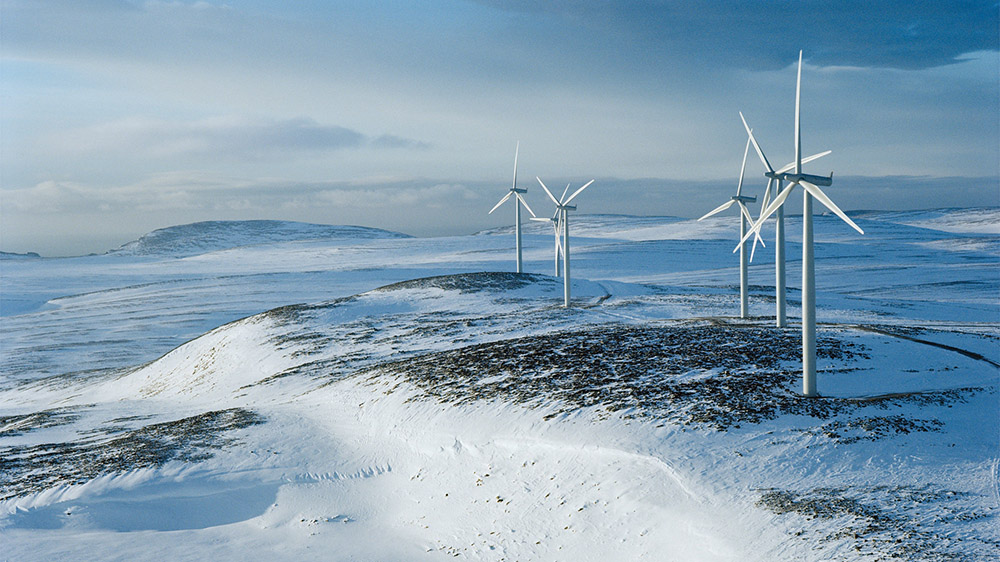
Windmills at Kjøllefjord, Finnmark. Photo: Statkraft
Project description
SAMVIND aims to develop a novel methodology to integrate well-being and other socio-technical parameters into energy system modelling (ESM).
Background
Decarbonisation of the energy system is key to limiting global temperature rise to below 2°C; a goal which can be achieved by electrified and interconnected systems with an emphasis on integrating various renewable energy sources. This transition is shaped by uncertain factors, which include technology innovation, resource availability, and socio-economic variables. Energy system modelling (ESM) has been a key tool in developing decarbonisation pathways by providing stakeholders in the energy sector with knowledge-based and systematic methods to determine which technologies to support. However, present-day ESM mainly integrates techno-economical input parameters, whereas social factors, such as community perspectives on new installations, are largely understudied. ESM might therefore produce solutions that do not include local communities' views, knowledge and needs and as a result, could jeopardize decarbonisation targets.
The main goal of SAMVIND is to develop a novel methodology to integrate well-being and other socio-technical parameters into ESM. This will allow the defining renewable energy scenarios for Norway that consider community perspectives and contribute to identifying socially just decarbonisation pathways in Europe.
About the project
SAMVIND aims to develop an innovative and interdisciplinary mixed-methods approach integrating concepts of sociology (stakeholder analysis), economic philosophy (capability approach), and technology systems (energy systems modelling) to better define the ‘real world’ feasibility of large-scale wind farms from a range of economic, political, regulatory, and societal perspectives. This new methodology will be developed and applied to the case of Norway, a country with excellent wind resources but high local opposition towards their development. The selected case studies are the municipalities of Berlevåg in Finnmark and Aremark in Østfold. Research methods will follow a community-led approach that will include participant observation, conversations with community members, authorities, and other stakeholders, workshops, and hopefully a larger-scale participatory survey.
Once data has been analysed and processed, the economic, political, regulatory and societal dimensions will be documented to provide guidelines for considering the knowledge and perspectives of communities in Norway about wind energy. These factors will then be built into a ‘socially informed’ highRES model for renewable energies in Norway to determine their effects on decarbonisation strategies, as well as the cost-benefits of mitigating these factors.
The outcomes of this research will a) increase the understanding of community perspectives of renewables; b) develop empirical insights into how stakeholder interests and conceptions of well-being impact wind energy scenarios; and c) advance a new methodology to represent community perspectives, stakeholder interests and well-being into ESM.
By following this community-led approach, SAMVIND will benefit society by providing new decarbonisation scenarios that aim to expand affordable, reliable, and sustainable energy while considering perspectives of well-being and social justice of communities where renewable energies are installed. These scenarios will require policymakers at the national and EU levels to introduce sufficient flexibility within regulatory frameworks to account for local knowledge, needs and aspirations.
The project is led by Paola Velasco Herrejón, postdoctoral research fellow at the Department of Technology Systems at the University of Oslo and co-researchers Henny Fossnes Kurland (NMBU), Ruby Griffin Solheim (UiO), Aina Helene Guttorm Einarsen (UiO) and Charles Tillinghast (UiO).
Duration
January 2023 – May 2027
Funding
This project is funded by the European Union under grant agreement No 101061882 (Marie Skłodowska-Curie Actions).
Cooperation
Johannes Schmidt at the University of Natural Resources and Life Sciences-BOKU (Vienna, Asutria).